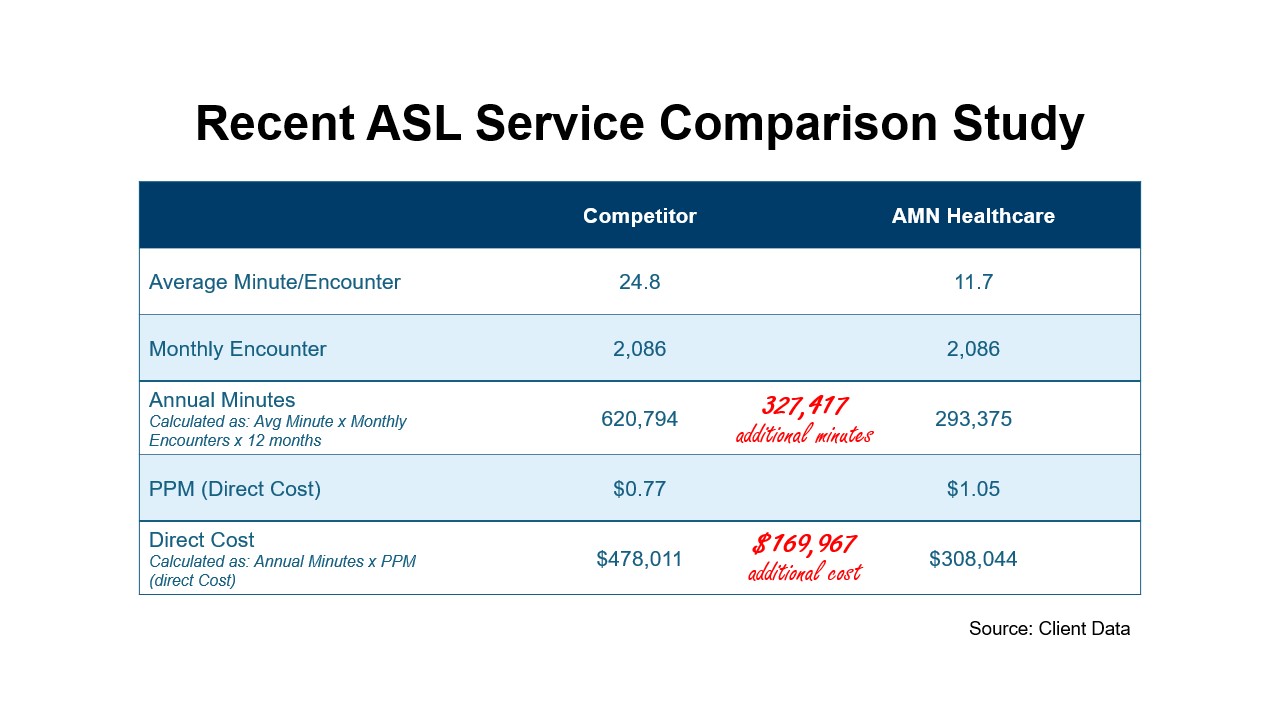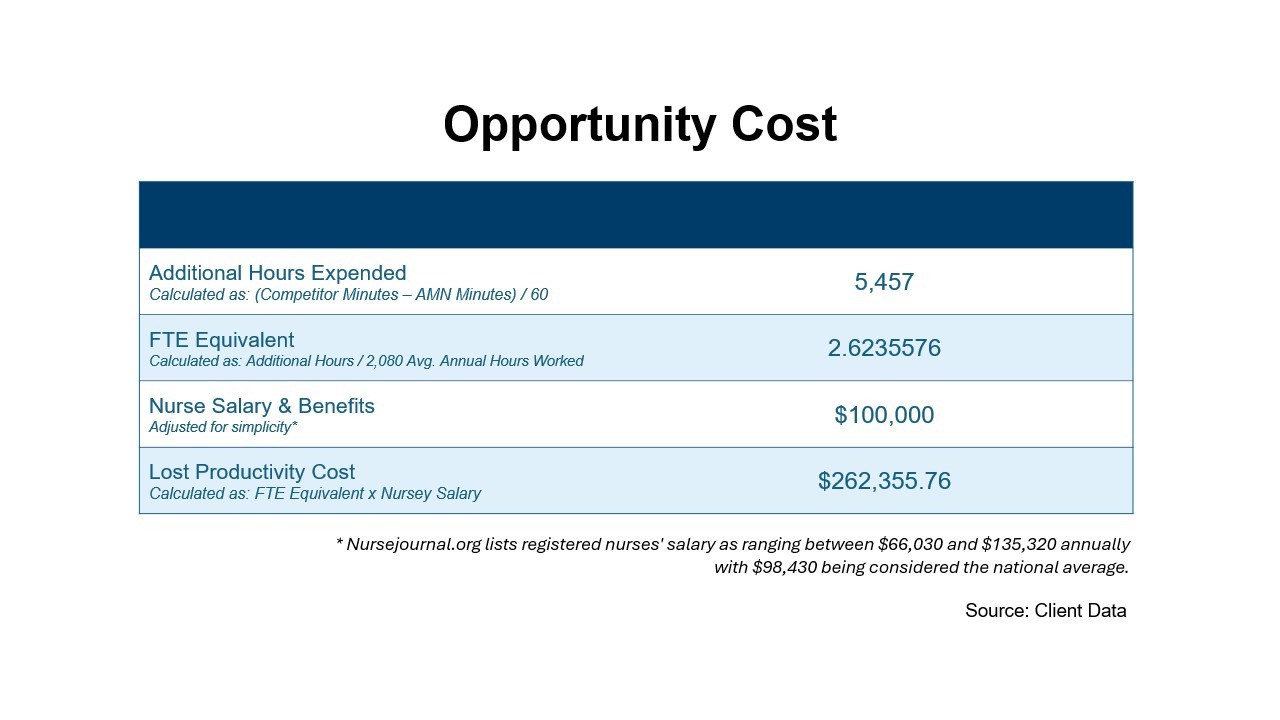
The Real Cost of Communication: Rethinking Price Per Minute in Language Services
For millions of Americans with Limited English Proficiency (LEP), as well as Deaf and Hard of Hearing (DHH) patients, access to qualified medical interpreters can be the difference between confusion and confidence, delay and decisive care. But when health systems weigh their language services options, price per minute often dominates the conversation. Industry experts and recent studies, however, suggest this narrow focus can obscure more significant—and costly—factors.
The Hidden Costs of Language Services
At first glance, interpreter fees seem straightforward. Interpreter rates are easily quantified, but true costs involve multiple factors. Healthcare leaders seeking true value must look beyond invoices to operational realities: encounter times, staff productivity, and opportunity costs.
The real cost of language services unfolds during each encounter, and every minute matters. Language service providers who promise the lowest per-minute rates may cost health systems more in the long run, because extended connection or session times directly translate to wasted staff resources and frustrated patients.
Connection Time: Fast, Reliable Access When It Matters Most
AMN Healthcare Language Services invests in a purpose-built video platform engineered for stability, speed, and reliable performance—even in low bandwidth environments. But technology alone is only part of the equation. We also prioritize interpreter supply and availability, ensuring rapid response times, day or night. It’s not uncommon for healthcare organizations to report connection times of up to 3, 5, or even 10 minutes with other providers—delays that add up quickly. By combining a healthcare-exclusive platform with an expansive roster of interpreters, we deliver average connection speeds of 15 seconds or less (as of 2025).
This difference compounds thousands of patient encounters per month. Plus, EHR integration saves valuable provider time on the back end, enabling the next patient to be seen sooner.
Session Duration: Efficiency Without Compromise
A lower price-per-minute means little if the interpreter cannot facilitate precise, empathetic communication. The quality of your interpreter network impacts encounter length, clinical outcomes, and patient satisfaction—and thus overall cost.
Specialized Training, Measurable Results
Our interpreters are healthcare-exclusive, rigorously trained, and nationally certified. For example, sign language interpreters hold NAD Level 4+, RID CSC, or NIC credentials plus two years’ experience; spoken language interpreters must demonstrate fluency, undergo comprehensive training, and pass proficiency assessments.
This commitment shows real-world results. After partnering with AMN Language Services, Onvida Health, serving diverse communities in Southwest Arizona, Onvida Health’s encounter times decreased, and staff confidence rose. After factoring in strategic interpretation device placement, decreased connection time and decreased session duration, Their Director of Experience confirmed that “the time to provide effective communication has been greatly reduced by 15+ minutes per encounter.”
Poorly trained interpreters—or those unfamiliar with medical terminology—contribute to longer encounters, confusion, and even repeat visits or costly medical errors. Our standards and training ensure effective, first-time-right conversations for every patient. For an inside look at interpreter training at AMN Language Services, read this article featuring our Director of Training and Development.
Opportunity Costs: When Waiting Hurts the Bottom Line

Labor efficiency is an indirect cost that needs to be considered. Let’s look at this real-world comparison from one of our clients who used a lower cost-per-minute option. The chart above represents their ASL session durations and demonstrates delays in interpreter connection and extended encounter times. The extended session times translate into additional direct cost, and notably, lost minutes for clinical staff, who remain engaged but unable to advance other patient care activities. In plain words, clinical staff are waiting around due to slow technology and less experienced interpreters. Let's take a closer look at the meaning of this data:
Experienced registered nurses (RN) earning $100,000 a year are ready to provide care, but instead, they’re stuck waiting for inefficient language services technology. Over the course of a year, each of those nurses spends 5,457 hours waiting. That’s the same as the combined workload of 2.6 full-time nurses' worth of time wasted. Let’s put a dollar figure on that wasted time. Those hours add up to $262,355.76 in lost productivity. Combine that with the $169,967 additional direct cost from the increased connection time and session duration, the total additional cost skyrockets to $432,322.76 per year. And here’s the kicker: that’s just the cost of nurses for one language (ASL).

Picture the ripple effect. What happens when you factor in the time wasted by physicians, who earn even more? Or the impact on patient care when staff are tied up waiting instead of helping people (which also means lost revenue)? The true cost of choosing an inferior technology isn’t just financial—it’s about time, care, and lives.
Workforce Model: Excellence Through Balance
It is less considered, but a vendor’s interpreter supply model can also affect session durations, and thus, the costs. Sometimes, contract interpreters (1099) are optimal—especially to secure rare languages or provide overnight and after-hours coverage. Their flexibility allows them to meet every need.
However, over-reliance on 1099 contract interpreters can have its disadvantages. Paid by the minute of active the interpretation session, contractors are not incentivized to be available immediately or prioritize efficiency or transfer calls to the most qualified peer, which can impact encounter times and communication quality.
AMN Language Services’ combined model empowers stability and excellence. With 95% of call volume managed by dedicated employee interpreters we ensure alignment with health system goals: improved accountability, consistent quality, and better staff engagement. Our hybrid approach delivers the coverage flexibility and operational consistency required for superior patient care.
Operational and Financial Benefits: From Complicated to Conquered
AMN Language Services delivers over 271 million interpretation minutes annually and supports several thousand healthcare-exclusive interpreters. Our technology integrates seamlessly into clinical workflow and delivers leading-class user experience.
Investing in sophisticated language solutions yields quantifiable returns:
- In many situations, like the one listed above, there is up to a 50% reduction in interpreter minutes per encounter
- 9/5 average provider interpreter rating in 2024 and 2025
- Improved staff morale and reduced appointment delays
- Sustained patient satisfaction, boosting health literacy and loyalty
- Full compliance with the Joint Commission and Section 1557 of the Affordable Care Act
When clinical teams are empowered with quality interpreters—on best-in-class platforms—they spend less time waiting, communicate more effectively, and deliver care that meets the highest standards.
A Blueprint for Strategic Leadership
Healthcare executives face a strategic choice. Chasing the lowest price per minute can result in hidden costs, operational setbacks, and diminished clinical effectiveness. True value emerges from looking holistically—beyond the invoice—to consider encounter times, connection speed, interpreter skill, and integration with clinical operations.
Leaders who align language access strategy with comprehensive quality metrics drive both financial and care delivery objectives forward. AMN Healthcare is ready to partner for this success.



